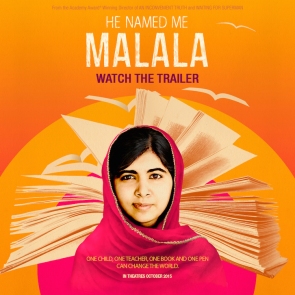
He Named Me Malala focuses on the heroism of not only Yousafzai, but her dad.
By Marie D’Andrea
Malala Yousafzai was shot in the head for promoting women’s education. Having remarkably survived this attack, the young Pakistani female has become a symbol of hope for women seeking education across the globe. Today, she is a winner of the 2014 Nobel Peace Prize, as well as the author of her best-selling autobiography, “I am Malala: The Story of the Girl Who Stood Up for Education and was Shot by the Taliban.” Yousafzai continues to be an advocate for women’s rights – primarily education – as she shares her story with the world.
Inspired by her story, director Davis Guggenheim sat down with Yousafzai and her father, who is the owner of a chain of low-cost private girls’ schools in Pakistan. In Guggemheim’s new documentary, He Named Me Malala, he unveils the story of a young, feisty female on a mission. Despite the in-depth detail of her autobiography, Guggenheim’s chronicle of Yousafzai’s journey makes for an inside look into the life of a spirited adolescent. The film also sheds light on the influence of Yousafzai’s biggest fan, her father.
I had the incredible opportunity to speak with Guggenheim in a phone conference last week. The director spoke of his experience working with Yousafzai and her father in a way that showed her father’s curiosity and dedication to his child.
At one point he was cornered by another college student with the question: “What would you do in Malala’s father’s situation? Would you support her continuing to fight for what she believed in despite the possibility of more danger?” Guggenheim let out a sigh and paused before responding to this, carefully crafting his response in what he wanted to be the most sincere and genuine way possible: “I used to leave their house after interviewing and filming each night wondering what I would do in her father’s situation. As the father of two girls, I would like to say yes, I’d be able to do what he did.”
The most significant idea he continued to reiterate was how important it was to him for channel the perspective of a young female in the documentary. He explained that he wanted the documentary to appeal to young females all over the world, and hoped that they would be inspired by Yousafzai’s struggle, as well as her continued fight for women. After hearing this, I realized that there was only one question I had for the director: “Mr. Guggenheim, what best allowed you to channel the perspective of Malala in the film? Or rather, to channel the perspective of a young female, since you are, in fact, not a young female…” He finished my trailing sentence for me, joking, “since I am, in fact, a 51-year old man.” His response was inspiring. He began by stating that the one thing he feels he is best at is, “being a very empathetic person. I try to get inside people’s brains, that’s my job. I tried to get Malala to speak about things she’d never spoken about before. Some of my best moments with Malala were spent just sitting with her at her kitchen table one night, talking.”
Guggenheim ended with words that summed up his own mission: “It’s my job to sort of help people burst, and give birth to their own story.” These words have resonated with me ever since. I would like to think that is exactly what Malala feels is her job, as well — to make people feel bothered, to provoke a sense of passion and purpose in others so that they may be moved to act. And in acting, perhaps, give birth to their own stories, too.
Yousafzai, now age 18, remains a fervent activist of women’s education today. She started a global movement, inspiring thousands, helping them burst. “Malala” can be translated as “grief-stricken” from an Afghan dialect called Pashto; it is safe to say that this young woman is anything but that.
“He Named Me Malala” is now playing in local theaters.
